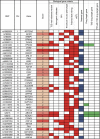Genome-wide association studies in the Japanese population identify seven novel loci for type 2 diabetes
- PMID: 26818947
- PMCID: PMC4738362
- DOI: 10.1038/ncomms10531
Genome-wide association studies in the Japanese population identify seven novel loci for type 2 diabetes
Abstract
Genome-wide association studies (GWAS) have identified more than 80 susceptibility loci for type 2 diabetes (T2D), but most of its heritability still remains to be elucidated. In this study, we conducted a meta-analysis of GWAS for T2D in the Japanese population. Combined data from discovery and subsequent validation analyses (23,399 T2D cases and 31,722 controls) identify 7 new loci with genome-wide significance (P<5 × 10(-8)), rs1116357 near CCDC85A, rs147538848 in FAM60A, rs1575972 near DMRTA1, rs9309245 near ASB3, rs67156297 near ATP8B2, rs7107784 near MIR4686 and rs67839313 near INAFM2. Of these, the association of 4 loci with T2D is replicated in multi-ethnic populations other than Japanese (up to 65,936 T2Ds and 158,030 controls, P<0.007). These results indicate that expansion of single ethnic GWAS is still useful to identify novel susceptibility loci to complex traits not only for ethnicity-specific loci but also for common loci across different ethnicities.
Figures




References
-
- McCarthy M. I. Genomics, type 2 diabetes, and obesity. N. Engl. J. Med. 363, 2339–2350 (2010). - PubMed
-
- Imamura M. et al.. Genetics of type 2 diabetes: the GWAS era and future perspectives. Endocr. J. 58, 723–739 (2011). - PubMed
-
- Unoki H. et al.. SNPs in KCNQ1 are associated with susceptibility to type 2 diabetes in East Asian and European populations. Nat. Genet. 40, 1098–1102 (2008). - PubMed
-
- Yasuda K. et al.. Variants in KCNQ1 are associated with susceptibility to type 2 diabetes mellitus. Nat. Genet. 40, 1092–1097 (2008). - PubMed
-
- Yamauchi T. et al.. A genome-wide association study in the Japanese population identifies susceptibility loci for type 2 diabetes at UBE2E2 and C2CD4A-C2CD4B. Nat. Genet. 42, 864–868 (2010). - PubMed
Publication types
MeSH terms
Substances
Grants and funding
- R01CA64277/CA/NCI NIH HHS/United States
- BC050791/BC/NCI NIH HHS/United States
- R37 CA070867/CA/NCI NIH HHS/United States
- KO1TW006087/TW/FIC NIH HHS/United States
- R01 DK082766/DK/NIDDK NIH HHS/United States
- R01 CA064277/CA/NCI NIH HHS/United States
- R01 CA124558/CA/NCI NIH HHS/United States
- 268834/ERC_/European Research Council/International
- R37CA070867/CA/NCI NIH HHS/United States
- R01DK082766/DK/NIDDK NIH HHS/United States
- R01CA124558/CA/NCI NIH HHS/United States
- UM1 CA182910/CA/NCI NIH HHS/United States
- UL1 RR024975/RR/NCRR NIH HHS/United States
- WT_/Wellcome Trust/United Kingdom
- SP/09/002/BHF_/British Heart Foundation/United Kingdom
- K01 TW006087/TW/FIC NIH HHS/United States
- G0800270/MRC_/Medical Research Council/United Kingdom
LinkOut - more resources
Full Text Sources
Other Literature Sources
Medical

